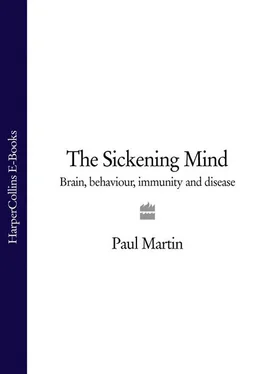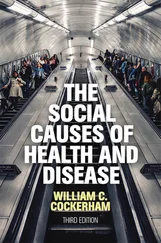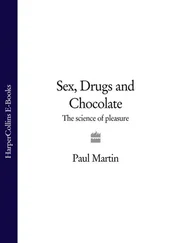The importance of psychological factors in tuberculosis was widely acknowledged until well into this century. As early as 1500 BC, Hindu scripts described a wasting disease – almost certainly tuberculosis – of which one of the main causes was said to be sadness. Hippocrates, Galen and other medical luminaries of ancient Greece taught that grief, anger and other strong emotions played a major role in tuberculosis.
Throughout the seventeenth, eighteenth and nineteenth centuries many eminent European physicians stated that the causes of tuberculosis (or phthisis , as it was then known) included mental states such as ‘a long and grievous passion of the mind’, ‘a mournful disposition of the soul’, ‘ungratified desires’, ‘profound melancholy passions’ or ‘disappointment in love’. During the eighteenth and nineteenth centuries, students of tuberculosis refined the theory of a link between the disease and a specific set of psychological characteristics. This was formalized in the concept of the tuberculosis-prone personality, or spes phthisica . As we shall see later, modern science has revived the concept of disease-prone personality types with the discovery of certain intriguing associations between personality traits, heart disease and cancer.
More familiarly, we have the romantic nineteenth-century notion that consumption (as tuberculosis was then known) is caused – or, more accurately, exacerbated – by an artistic temperament. Consumptive artists or writers were believed to be consumptive primarily because of their excessive artistic and aesthetic emotions, which literally consumed them. Consumption came to be something of a status symbol among the chattering classes.
Countless noted writers, artists and musicians of the nineteenth and early twentieth centuries did indeed suffer from consumption. Emily Brontë is but one example. She died of tuberculosis, a bitterly disappointed woman, within a year of Wuthering Heights being published to withering reviews. Other creative victims of tuberculosis included John Keats, Frédéric Chopin, Robert Louis Stevenson, Stephen Crane, Katherine Mansfield, Robert Tressell, D. H. Lawrence, George Orwell and Franz Kafka. It is said that Kafka’s health was weakened by his chronic unhappiness, his hypersensitive personality, his problematic relationship with his father and several unfortunate romantic tangles. He died in an Austrian sanatorium in 1924, aged forty-one.
On the other hand, tuberculosis accounted for more than one in five of all deaths in the nineteenth century and was still common in Europe until well into this century. On statistical grounds it is hardly surprising that at least some prominent names were included among its victims.
The fiction of the eighteenth and nineteenth centuries reflects this preoccupation with tuberculosis and the prevailing attitudes towards it. We can choose from a panoply of heroes and heroines who sink into tubercular decline in the aftermath of romantic tragedy. We have, for example, the ever popular tale of La Dame aux Camélias , Alexandre Dumas the younger’s tear-jerker about the passionate but doomed love affair between Armand Duval and the enchanting courtesan Marguerite Gautier.
The young Duval meets Marguerite and is captivated by her. They become lovers. Marguerite is already consumptive, but under the healing influence of Armand’s love she abandons her dissolute lifestyle and her health improves. Meanwhile, Armand’s well-meaning father secretly persuades Marguerite that if she truly loves Armand she will leave him for his own good. Marguerite demonstrates her love for Armand by doing just that.
The cynical Armand thinks Marguerite has abandoned him out of boredom so that she can resume her former life of late nights, promiscuity and wild self-indulgence. He therefore sets out to punish her by humiliating her at every opportunity and revelling in the spectacle of her suffering:
… for the last three weeks or so, I had not missed an opportunity to hurt Marguerite. It was making her ill … Marguerite had sent to ask for mercy, informing me that she no longer had either the emotional nor physical strength to endure what I was doing to her.
As a consequence of her deep unhappiness at their separation and the psychological battering she receives from Armand, the much-wronged Marguerite goes into terminal decline. Her consumption flares up and she expires. Armand realizes his error, but not until too late. 4 As the narrator sagely concludes: ‘I have learned that one such woman, once in her life, experienced deep love, that she suffered for it and that she died of it.’ Though Marguerite dies from tuberculosis, it is her emotions that have killed her. La Dame aux Camélias was, incidentally, modelled on Dumas’ personal experience following his affair with the courtesan Marie Duplessis. Like the fictional Marguerite, Marie died of consumption not long after the affair ended. 5
Until the early part of the twentieth century, popular medical literature was largely in tune with fiction in the way it emphasized the importance of psychological and emotional factors in tuberculosis. To quote one everyman’s guide to medicine from the 1930s:
Happiness is a mighty important factor in the treatment of tuberculosis … Mental brooding and loss of hope of recovery or of checking tuberculosis tends to drag the unfortunate individual into a deep chasm from which escape is rare.
So, what happened and why have attitudes changed?
What happened was that in 1882 the German scientist Robert Koch announced to the world that he had discovered the real cause of tuberculosis – the tubercle bacillus, Mycobacterium tuberculosis . Once it became known that tuberculosis was a bacterial infection, scientific interest in the role of psychological and emotional factors rapidly dwindled. The pendulum swung violently from the psychological to the physical. Open a contemporary medical text on tuberculosis and the chances are you will find little mention of psychology, emotions or the mind.
A lot of the old ideas about tuberculosis were plain wrong in their assumption that mental forces were sufficient to produce the symptoms by themselves; tuberculosis is undoubtedly a bacterial infection. Moreover, identifying a specific physical cause was immensely beneficial because it enabled medical science to find an effective remedy. Improvements in social conditions in the early twentieth century, followed by the introduction of effective antibiotics after the Second World War, led to an enormous decline in the incidence of tuberculosis in industrialized nations.
And yet it remains true that psychological and emotional factors do play a role in the disease. Later in this book we shall see how. It is not the nature of the tuberculosis that has changed, but the attitudes and interests of medical science.
The misleading distinction between illnesses that are ‘physical’ (in other words, real) and illnesses that are ‘psychological’ (and therefore by implication not real) is starkly illuminated by the furore over chronic fatigue syndrome, otherwise known as myalgic encephalomyelitis (ME), post-viral fatigue syndrome or, if you read the tabloid press, yuppie ’flu.
It is with some trepidation that I thrust my head into the lion’s den of controversy over the causes of chronic fatigue syndrome. Fierce arguments continue to rage and the medical establishment has yet to reach any consensus. In excess of eight hundred scientific publications have been devoted to the subject and the picture changes almost weekly. Those who suffer from the illness often have passionate views about its origins and anyone who gainsays them is asking for trouble.
The debate about chronic fatigue syndrome is relevant here because it exemplifies the false dichotomy between ‘psychological’ and ‘physical’ origins of illness. Throughout the controversy runs a seductively misleading vein: the implicit assumption that the illness must be either physical or psychological in origin. But first, what exactly is chronic fatigue syndrome?
Читать дальше












